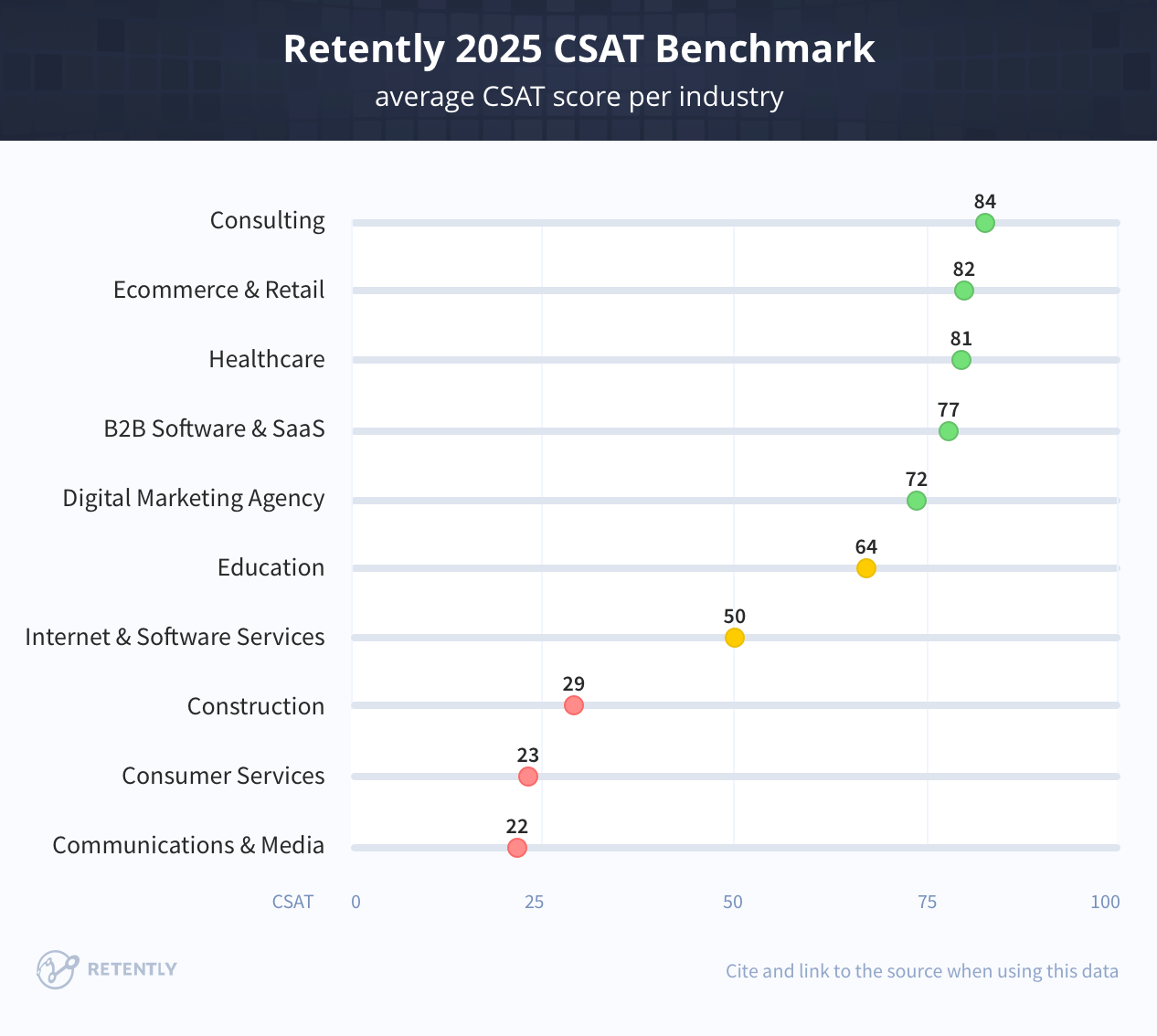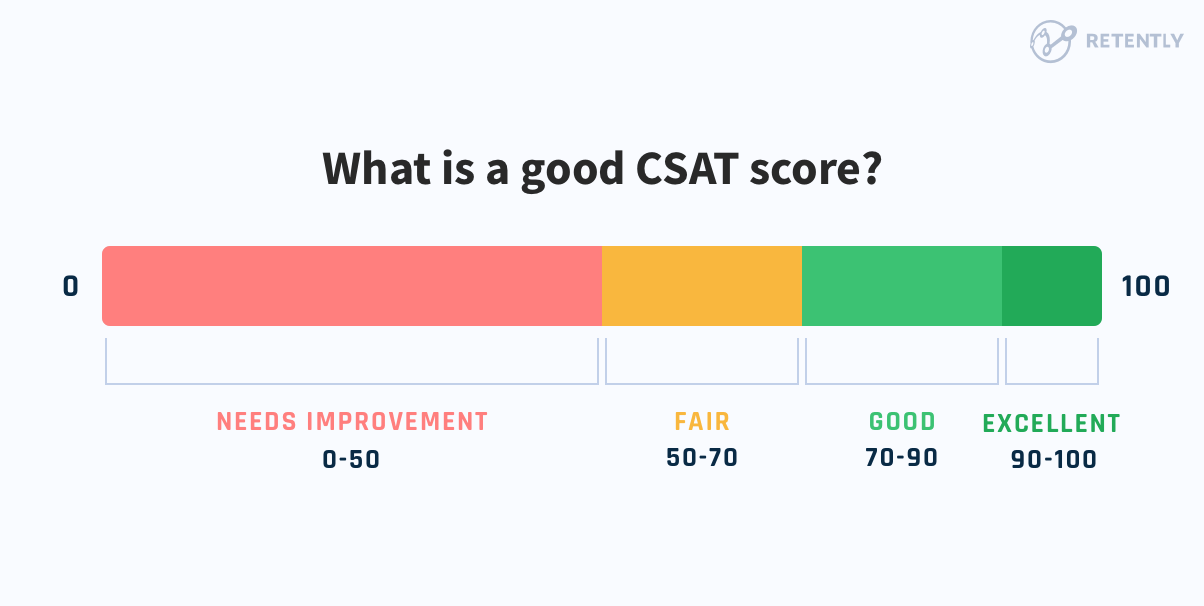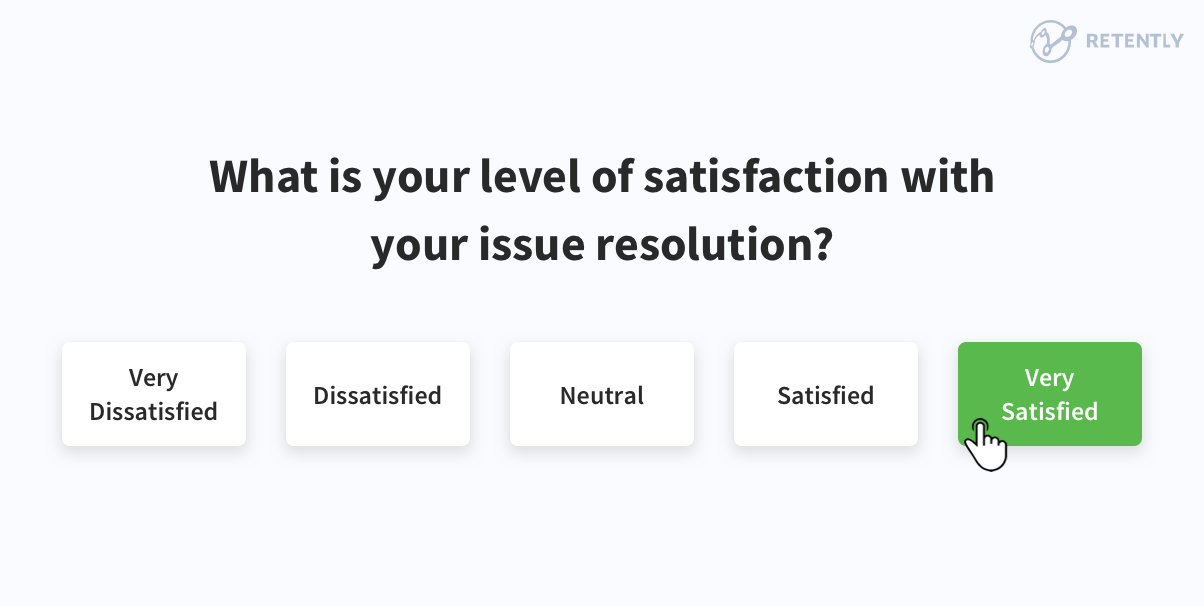Being exposed to negative word-of-mouth or having clients leave due to unpleasant interactions are experiences no business would want to lose control over.
But how do you prevent situations like that from getting out of hand? By keeping track of customer satisfaction throughout the customer journey to see when you need to address complaints and implement feedback to keep them satisfied.
One of the best ways to do that is by tracking customer satisfaction metrics. There are some options to choose from (NPS, CES, and CSAT), and – in this article – we’ll be taking an in-depth look at CSAT. So, what is CSAT?
Key Takeaways
- CSAT captures how happy customers are with a specific interaction, product, or experience – often right after support or at key lifecycle touchpoints.
- A satisfied customer today might not stick around tomorrow. CSAT is great for tracking short-term satisfaction, but not long-term retention or brand advocacy (that’s where NPS comes in).
- A “good” CSAT score depends on your sector, but generally, anything above 70% is considered a good place to be in.
- A single score matters less than how it moves over time. Focus on improving trends and closing feedback loops.
CSAT Meaning
CSAT (Customer Satisfaction Score) is a survey methodology used to measure a customer’s satisfaction with a business, product, or service.
The CSAT question format is usually something along the lines of “How satisfied were you with your experience/our product/service today?”. Customers can offer a CSAT rating on a 1-5, 1-7, or 1-10 range on a “Very Satisfied-Very Dissatisfied” scale, or show their satisfaction/dissatisfaction through other CSAT metrics (like stars, for example).
The purpose of CSAT is to collect user feedback and gain insights into areas for improvement in order to enhance the customer experience.

How to Calculate CSAT?
There really isn’t a universal approach to measuring the customer satisfaction score (CSAT). You can actually implement a measurement process that works best for your business. If you’re low on ideas, though, here are the most common ways CSAT scores are measured:
1. Calculate the Average CSAT Score
If your surveys use numeric ratings, you can do an average based on all the scores you got. The CSAT formula, in this case, is to add up all the scores and divide that sum by the number of respondents.

Here’s an example – let’s say your CSAT survey has 20 respondents, and the sum of all their scores is 80; that means you have an average customer satisfaction score of 4. Yet, keep in mind that this calculation provides an average value as a reference point and does not show the CSAT score percentage.
There are various methods to convert this average into a percentage, considering either the highest or the lowest possible score. Nevertheless, it’s worth noting that these alternative formulas may produce differing results for the CSAT score. To avoid confusion, we’d like to highlight the generally accepted CSAT calculation formula instead.
A simpler and most common way to calculate CSAT is to just take the number of “Very Satisfied/Satisfied” results, divide it by the number of total respondents, and then multiply it by 100. Following up on the example above, if you had 20 respondents, and 10 responses were “Very Satisfied/Satisfied,” you’d have a 50% CSAT score (0,5 times 100).

2. Use Happy-Neutral-Unhappy Ratings
It’s pretty simple – just have a Happy/Neutral/Unhappy face as a response option. Color them accordingly (Red – Unhappy, Green – Happy, Yellow/Gray – Neutral), and your respondents will have an easy time answering.
While this rating isn’t the most nuanced and in-depth, it is useful if you’re just looking for a quick way to check satisfaction levels. The CSAT score calculation is quite simple – just check the number/percentage of Happy emoticons.
Also, this kind of rating can be helpful if you’re worried that cultural bias might negatively impact your customer satisfaction score (if you want to know more about it, check out the CSAT Cons section below).
3. Use the Thumbs-Up/Thumbs-Down Approach
This binary system simplifies feedback, reducing it to a positive or negative response. It’s akin to a simplified version of the Net Promoter Score system.
The calculation formula is rather straightforward. The percentage of thumbs-up responses out of the total responses gives a direct measure of satisfaction. For instance, if 80 out of 100 responses are thumbs-up, the CSAT score could be represented as 80%.
This format is particularly useful in industries where quick and straightforward feedback is valued. For example, in online content services (like streaming platforms), users can quickly indicate satisfaction or dissatisfaction, guiding other users’ choices and providing immediate feedback to the content provider.
4. Use 5-Star Ratings
The 5-star survey – having a star rating system applied – is another type of visual feedback you can use if you’re looking for a quick, convenient way to analyze CSAT results data. Star ratings offer a more nuanced view of satisfaction compared to the binary thumbs-up/thumbs-down, allowing customers to provide a range of feedback.
Plus, consumers will likely be very familiar with it since industry giants like Amazon also employ it. Actually, 5-star ratings are very common in ecommerce, hospitality, and service industries where customers are accustomed to providing such graded feedback.
In this case, an easy way to calculate the CSAT score is to see what percentage of 5-star ratings you have. Alternatively, you can just average out all your CSAT responses to get your overall score. Gorgias is a relevant example of software that calculates the CSAT score using this method.
5. Which Calculation Method Should I Trust?
While exploring specialized survey software, many of our potential customers address a very common question: why do various tools measure CSAT differently?
The question of whether to trust numerical or percentage results in the context of CSAT scores isn’t about which one is inherently more trustworthy, but which is more relevant and useful for your specific needs. Both are valid representations of customer satisfaction; however, their applicability depends on the context in which they’re used and what you’re aiming to understand or communicate.
Consistency in data presentation is key. If you’ve historically used numerical scores to track customer satisfaction, continue with that format to maintain comparability over time.
When benchmarking against other organizations or industry standards, use the format that aligns with the common practice in your sector or the format in which benchmark data is available.
Reflect on how the data was collected. Suppose your satisfaction metric derives from a scale (like 1 to 5 stars). In this case, a numerical average might directly reflect that data. If it’s a binary choice (like thumbs up or down), a percentage is a natural representation.
Consider how you plan to use the data. In case you need insights for internal analysis to drive specific improvements, a numeric average might be enough. If you’re aiming to communicate overall satisfaction levels, especially in a straightforward way that’s easily understood by a broader audience, percentages might be the better choice.
The key is choosing the method that best suits your specific needs, ensuring that it is applied consistently and interpreted correctly within your goals and industry standards.
At Retently, we chose to opt for the generally accepted CSAT calculation formula instead, hence a percentage representation that is easily comparable to industry benchmarks.
No matter the calculation method you go for, make sure it is transparent and understood by those who use the data. Whether it’s a numerical average or a percentage, clearly communicate how the score is calculated.
What Is a Good CSAT Score?
Despite the different rating systems, CSAT scores are usually calculated on a scale of 0 to 100 percent. Obviously, a 100% score means you are enjoying complete customer satisfaction levels.
While a 100% score is the goal, you’re not always guaranteed to see it. So, while you should aim for it, any score over 50% (ideally 60% or 70%) should be a good sign since it means that over half of the customers or responders are satisfied.
According to our experience, a perfect score of 100% is generally attained by companies with less CSAT feedback, and the score gets balanced as soon as more CSAT data floods in.
To have a better CSAT overview in terms of score, we’ve decided to turn to customer data for more insights. The results displayed by the Retently CSAT benchmarks show that a score between 65% to 80% is a dominant value across industries.

Thus, we’ve got the Consulting industry leading the CSAT benchmarks with an impressive score of 84. Ecommerce & Retail, although not in the driving seat any longer, enjoys a great CSAT score of 82.
Due to the pandemic, the Healthcare industry has paid close attention to customer satisfaction, which translated into improved values granted by their customers in the following years. Apart from a less generous 2024, the Healthcare industry streamed up to a CSAT score of 81.
Ecommerce & Retail have also experienced a good boost in their scores post-pandemic. COVID limitations have turned customer attention to the online, challenging the industry to keep up with customer expectations and an increased demand. In 2024, their customer-centric strategies paid off, bringing them to the forefront of Retently’s CSAT benchmark, although they could not hold to their position in 2025. Let’s see if they can get back on track in the year to come.
B2B Software & SaaS companies confidently approach their peers with a CSAT score in the high 70s, after an impressive leap in 2023. Digital Marketing Agency is following in their footsteps with a CSAT score of 72. Such industries as Internet & Software Services and Education are also keeping up the good work with customer satisfaction values of 50 and 64, respectively.
Communication & Media is, unfortunately, placed at the other end of the scale with an improved CSAT score of 22 compared to 2024. This is also the case when it comes to the NPS benchmarks for the respective industry.
Although industry benchmarking is useful for drawing some conclusions as to your own CSAT score, it’s important to remember that every business is unique and there are many factors to take into account (methodology, size of the survey sample, etc.).
Yet, while digging into the available data, we came up with this interpretation of the CSAT score and the value to aim for:

Hence, a score below 50 speaks of poor customer satisfaction that needs immediate action. Since almost half of the customers are not satisfied with the quality of the service or product, there is definitely room for a lot of improvement.
Companies in the 50 to 70 CSAT score range are in the safe realm as most of their customers are neither satisfied nor dissatisfied. These customers are not at risk to churn, nor are they very happy about their experience. While we don’t need to settle for a satisfactory result, it is a clear sign of a promising perspective if a proactive approach toward customer engagement is adopted.
A CSAT scoring between 70 to 90 seems to be a good place to be in. This is the average value range across industries, speaking of healthy customer engagement and delivery of great service. A CSAT score over 90 – well, is an excellent result every company should aspire to, accounting for exemplary customer service standards and impressive customer satisfaction levels.
Companies preferring the popular 1-5 CSAT rating may find this approach to CSAT score meaning more accurate, setting the 65 to 80 range as a good one:
- 0-35 very bad/highly unsatisfied
- 35-50 poor/unsatisfied
- 50-65 average/quite satisfied
- 65-80 good/satisfied
- 80-100 excellent/highly satisfied
How to Design an Effective CSAT Survey?
To get an accurate customer satisfaction score (CSAT), you must enjoy good survey response rates. Here are the main tips to consider for building efficient CSAT surveys:
1. Keep It Simple
According to SurveyMonkey’s research, a responder will spend an average of 75 seconds on a question – if the survey has only 1 question. If your survey has anywhere between 3-10 questions, the time goes down to 30 seconds per question.
Whether you plan on including just one or multiple questions in your CSAT survey, make sure you make them as clear and straightforward as possible. Don’t use complicated words, technical jargon, or long sentence structures.
2. Ask Targeted Questions
There is a general tendency for respondents of long customer feedback questionnaires to give identical answers (the straight-line response pattern) to most or all of the survey items compared to those responding to shorter surveys.
In order to capture relevant CSAT data, be sure to limit the number of questions and focus on addressing the right ones. Map the critical touchpoints, set clear objectives and, hence, build relevant CSAT questions that could lead to the desired outcome. For instant question ideas tailored to your needs, make sure to check out the online survey generator.
3. Keep Ratings on the Same CSAT Scale
Although CSAT is quite flexible – offering different semantic, numerical or graphic values to choose from for a rating – sticking to the same approach across the CSAT survey would make it more efficient (especially if you go for a longer template). Keeping the CSAT rating within the same scale would make the survey less confusing and easier to interact with, resulting in more accurate data.
4. Include a N/A Option
Ideally, you should plan your survey in such a way as to ensure there are no irrelevant CSAT questions. However, having an “I don’t know” option is still an important safety measure since there’s always a chance some clients just might not find particular questions relevant.
If you don’t do that, you’ll basically be forcing customers to answer unrelated questions, meaning you won’t get actionable CSAT feedback.
5. Don’t Make Text Fields Mandatory
While text fields can be a great source of insightful CSAT data and feedback, making them mandatory will backfire.
It’s pretty obvious why – if they’re optional, really passionate customers will take the time to offer valuable suggestions. But if they’re mandatory, you’ll likely have annoyed clients filling them out with information that isn’t helpful. What’s worse, if they’re already unhappy, a mandatory text field might make them even more upset with your brand.

When Is the Right Time to Send a CSAT Question?
Timing your surveys is always important. Since the CSAT survey focuses on isolated interactions across the customer journey, the customer experience must be fresh in mind to give your company relevant feedback.
Depending on the nature of the interaction, you can choose the most appropriate distribution channel for your CSAT survey: email, in-app, SMS, or via link (survey kiosks are also an option). According to our research, these are the best moments to send a CSAT survey to your customers:
1. After Customer Support/Customer Service interactions
CSAT was developed to measure the quality of service and hence track the performance of individual teams. CSAT surveys are thus often used for assessing such aspects as quality of communication, expertise, speed, the efficiency of issue resolution, or the overall experience based on the latest interaction.

They are triggered to gauge customer sentiment in relation to the received service. These CSAT survey questions look into how the customer perceives the event or the support agent – not the overall perception or loyalty.
These are some of the most appropriate times to send CSAT questionnaires since they give you insights into whether or not you need to improve the customer engagement experience.
2. Before a Renewal
Sending a CSAT survey by email a few months before a customer decides whether or not to renew their service is a smart move because it gives you enough time to implement any critical feedback that might make it more likely for existing clients to renew their subscriptions.
If your business doesn’t work on a subscription model but a retail/product one, you could send CSAT surveys a few months prior to announcing a new product or every few months/every month to re-ignite a client’s desire to make another purchase.
3. After a Product Feature Release
A CSAT survey can be shared after a product update to gain insights into how well your customers have adopted the feature changes. For more targeted feedback, conduct in-app CSAT surveys as users get the chance to test out the additions and report any possible issues or frustrations as they arise.
4. At Key Customer Lifecycle Touchpoints
You can tie CSAT surveys to any key moments (depending on the specifics of your industry) within the customer lifecycle to see what changes you need to make to optimize the conversion process and boost retention rates.
For instance, you could send a CSAT survey after the onboarding process to see if there are any changes you can implement to make the process more straightforward, engaging, and intuitive.
Or you could trigger a CSAT survey after a purchase is completed or after the delivery of the respective items to help you assess your after-sale performance.

The Advantages and Disadvantages of Using CSAT
CSAT surveys can be versatile tools, but – sadly – their disadvantages outweigh their advantages. Let’s have a quick look at its pros and cons for a better CSAT overview:
CSAT Pros
One of the main advantages of CSAT surveys is that they’re intuitive and very straightforward – they’re easy to set up, and it doesn’t require a lot of effort on your respondents’ part.
They’re also quite flexible since you can customize the rating system to better resonate with your audience and make it more relevant for the context.
Besides that, CSAT lets you tweak the format (from a simple one to a more complex version) to make it more engaging. Also, CSAT surveys tend to get a pretty decent response rate because they don’t usually feature a lot of questions.
CSAT Cons
One of the main problems with CSAT surveys is data ambiguity. CSAT customer satisfaction data that are benchmarked across various industries can vary a lot, which might make it a bit hard to determine what is a good or bad CSAT score for your own industry.
Plus, benchmarking said data against competitors and communicating results to stakeholders might be difficult if you rely on an established survey company to handle the process since they might have a different scoring method that might not be 100% relevant to your business context.
CSAT results might also be skewed if some respondents who’d normally answer with a neutral response don’t fill out the survey.
What’s more, according to research findings, the CSAT customer satisfaction score can be influenced by cultural bias. Basically, if your audience is split between individualistic and collectivist countries, respondents might offer different ratings for the same experience. It seems that there is a clear tendency for collectivists to give responses that make the self look good, therefore they offer a more tame rating (“Satisfied/Not Satisfied”). Individualists, on the other hand, are not hesitant to go for more extreme ratings (“Very Satisfied/Very Dissatisfied”).
Lastly, the word “satisfaction” is subjective and means different things to different people. And consider this – when a customer gives a “Very Satisfied” rating, does that mean they are very happy with your whole brand or that they were satisfied with one of its aspects?
Don’t forget – satisfaction isn’t the same as loyalty, which is actually what makes customers love your brand and turn into word-of-mouth marketers for your products.
That’s not to say your CSAT score will necessarily take a hit because of that, but it’s worth noting that it can influence it.

Can You Predict Total Sales with Customer Satisfaction Score?
This is a tricky question, mostly because you can’t really use CSAT to efficiently predict business growth. Why? Because of these two issues:
- CSAT surveys reflect short-term sentiment. A customer’s answer is often based on how they were feeling on that specific day and on their last interaction with your brand – not their overall experience.
- As already mentioned, satisfaction doesn’t always equal loyalty. Just because a customer says they are “Very Satisfied” with your checkout process or customer support doesn’t necessarily mean they won’t jump ship to another brand if they get a better deal. As weird as it sounds, rating a service as “satisfactory” isn’t the same as calling it “amazing” or “excellent” since “satisfactory” is more of a neutral word.
Unfortunately, just asking clients how satisfied they are with an aspect of your service/product/brand isn’t going to give you enough data to predict growth.
Bottom Line
You can go wrong in many ways when putting together and delivering a customer satisfaction survey that can distort the picture of your customer experience. We have sliced and diced CSAT to give you an understanding of how it can be properly used to bring meaningful changes to your brand.
Whether you consider CSAT sufficient for your business goals or opt for a combined approach to customer satisfaction metrics, one thing remains unaltered: customer satisfaction surveys are an extremely valuable source of actionable insights on the delivered customer experience.
If you’re ready to put your customers first and tap into customer needs, it’s time to put this information into action. Build your CSAT survey in minutes and start collecting transactional data in a free 7-day trial.



































 Greg Raileanu
Greg Raileanu 



 Christina Sol
Christina Sol 
 Alex Bitca
Alex Bitca 